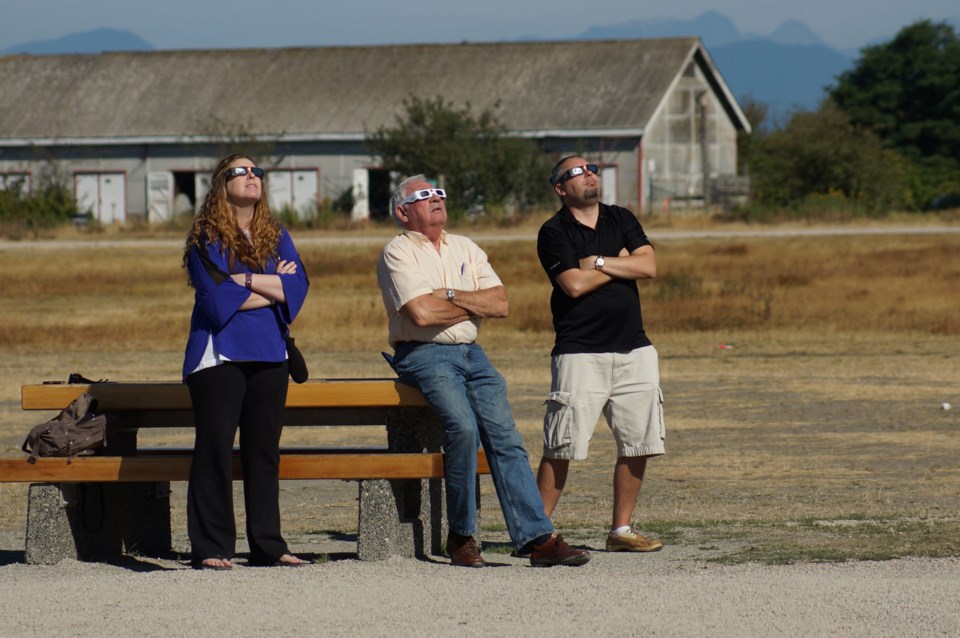On Monday morning, Richmond residents flooded into the city’s public parks and buried their heads in empty cereal boxes wrapped in tin foil.
Others viewed 86 per cent of the total solar eclipse with special sunglasses or through makeshift eclipse viewers.
At Garry Point Park, about 200 people witnessed the celestial event off the shores of the Fraser River, as Steveston fell under a noticeable light shade for about five minutes.
“We weren’t expecting it to be that dark. But when we took off our sunglasses it was extremely different,” explained Gabriel Santiago, 17, a Hugh Boyd secondary student, 19, who came to the park with brother David Santiago to view the eclipse.
The Santiago brothers came fully prepared with solar eclipse glasses as well as a cut-out cereal box, which reflected the eclipse via a pinhole.
“The cereal box didn’t work too well,” said David.
Several families set up lawn chairs and watched through the aforementioned boxes of Frosted Flakes, telescopes, smartphones and cameras, in addition to protective glasses, which were a tough find in the weeks leading up to the eclipse.
One man was creative enough to use his own hand by creating a fist only to leave a small hole in order to view the moon’s crescent reflected on the ground.
Up and down the West Dyke Trail, people stationed themselves for prime viewing locations.
At the peak of the eclipse, at 10:21 a.m., there was a slightly noticeable shade.
Maggie Lukban, a community programmer at Richmond Public Library, said she noticed a chill in the air, too.
Lukban helped organize a public viewing of the eclipse — which was viewed in its totality in Oregon — at the Brighouse plaza.
“You could tell when the moon went over the sun; it got dark and it got cool, too,” said Lukban.
There, members of the Kwantlen Polytechnic University physics department, including astronomers, were on hand to provide information and commentary on the event to about 300 people, said Lukban.
Astronomers used large telescopes to project the eclipse onto large white boards. Meanwhile, the library set up an outdoor screening of NASA’s live feed.
Indoors, people could view the eclipse on TV. One man got creative and brought a welding mask, added Lukban.
As an added bonus, children were shown models of planets moving around the sun and book collections on space.
Monday’s partial, solar eclipse was the closest Richmond has come to a total solar eclipse since Feb. 26, 1979, when southern Washington State experienced a total eclipse.
According to TimeAndDate.com, on Oct. 23, 2023, Richmond will see a partial, annular solar eclipse, whereby the moon doesn’t fully cover the sun, but creates a ring of fire effect as it passes by.
That eclipse’s trajectory will be similar to Monday’s, in that it will be fully visible from Oregon.
On Aug. 22, 2044, Richmond will see a similar portion of a total eclipse, which will be seen in its entirety in Edmonton and Calgary.
On March 13, 2025, Richmond will see a total lunar eclipse, also called a blood moon.
Astrophysicist and director of New York’s Hayden Planetarium Neil deGrasse Tyson was remindful this week, via Twitter, that total solar eclipses are not rare.
They “occur somewhere on Earth every two years, or so. So just calm yourself when people tell you they’re rare,” quipped Tyson.
Tyson tweeted during the event: “The divided United States of America will unite today, sharing a cosmic event predicted by the methods and tools of science.”
Meanwhile, for a brief moment during the eclipse, President Donald Trump was caught looking up at the sun without any protective glasses — which he eventually put on for a photo opp.



